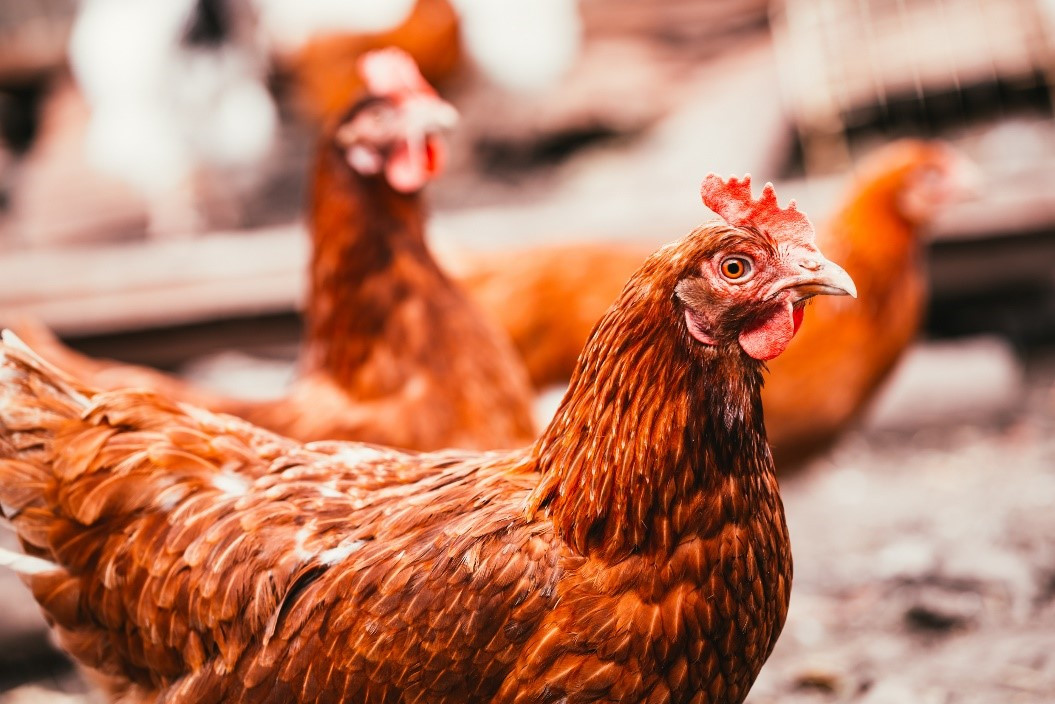
For layer hens to experience good animal welfare it is important they have enough space to move freely and express motivated and natural behaviours such as nesting during egg laying, perching, and roosting, foraging, and dust bathing. Hens require at least 540-1980cm2 of space per hen to move around and perform normal behaviours like turning around, flapping, and stretching their wings, and preening [1–3].
What is the legal indoor space requirement for layer hens?
The minimum space requirements for layer hens are stated in the Model Code of Practice for the Welfare of Animals: Domestic Poultry 4th Edition. The Australian Animal Welfare Standards & Guidelines for Poultry was released in 2022 and is intended to replace the Model Code of Practice once it is implemented in each state and territory jurisdiction.
Caged housing systems must provide at least 550cm2 of floor space per hen if more than two hens per cage and there are typically 3-7 hens per cage (equates to about 18 hens per m2). The RSPCA is opposed to housing hens in cages because of the inherently poor welfare outcomes, due to extreme confinement and behavioural restriction.
For cage-free housing systems (such as aviary, barn, and free-range), there is a maximum indoor stocking density of approximately 15 hens per m2 in sheds (30kg/m2). Hens in aviary systems are housed in large sheds which are vertically designed to contain multiple levels on which hens have access to perches, ramps, and nest boxes. Litter for dust bathing builds up on the floor of aviary systems. In barn systems hens are mainly housed on the floor or on a raised slatted area, or a combination of the two, with access to nest boxes and, sometimes, perches. Litter may or may not be provided in barn systems. In free-range systems, hens are housed in barn or aviary systems but are also provided with access to an outdoor range during the day.
What is the legal outdoor space requirement for free-range layer hens?
The Model Code of Practice recommends a maximum outdoor stocking density of 1,500 hens per hectare for free-range systems, however, this stocking density is not mandatory. The Australian Consumer Law (Free Range Egg Labelling) Information Standard 2017 allows for eggs to be labelled as ‘free range’ if laid by hens with ‘meaningful and regular access’ to the outdoors during daylight hours and with a maximum outdoor stocking density of 10,000 hens per hectare (the equivalent of 1 hen per m2). The Information Standard also requires egg producers to prominently disclose the outdoor stocking density on the egg carton, allowing consumers to easily compare the practices of different egg producers. The legal maximum density of 10,000 hens per hectare in Australia is much higher compared to several overseas countries. For example, the EU and New Zealand have a legal maximum outdoor stocking density of 2,500 hens per hectare.
What is the optimal amount of space for a layer hen?
For layer hens to experience good animal welfare it is important they have enough space to express normal behaviours like nesting, perching, dust bathing, foraging, stretching, wing flapping, exploring, and resting. Factors such as the breed and age of hens, temperature, humidity, ventilation, and air quality, litter provision, and whether outdoor access is provided in a shed will also influence how much space hens need to ensure good welfare.
Where hens also have outdoor access, the quality of the outdoor range areas is just as important as the space allowance. Outdoor range areas should be easy to access and encourage hens to use the range by providing palatable vegetation and trees, plenty of overhead shade/shelter, and protection from predators. To learn more about how to encourage hens to use outdoor areas in free-range housing systems, click here.
References
[1] Engel JM, Widowski TM, Tilbrook AJ, Butler KL, Hemsworth PH (2019) The effects of floor space and nest box access on the physiology and behavior of caged laying hens. Poult Sci 98:533–547
[2] Mench JA, Blatchford RA (2014) Determination of space use by laying hens using kinematic analysis. Poult Sci 93:794–798
[3] Dawkins M stamp, Hardie S (2007) Space needs of laying hens. http://dx.doi.org/101080/00071668908417163 30:413–416
